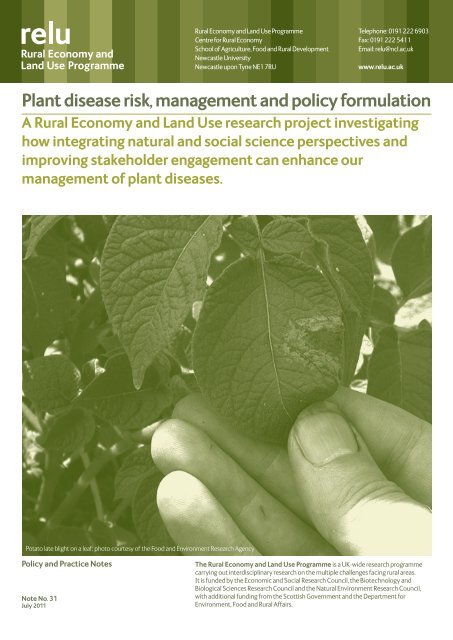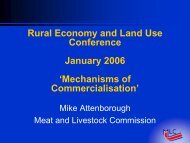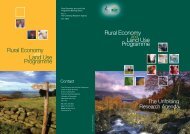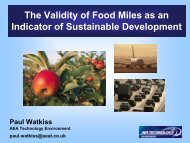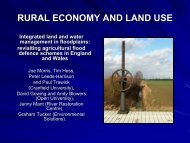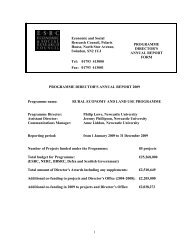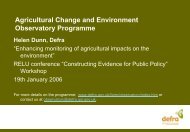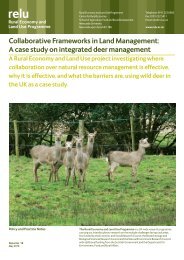Plant disease risk, management and policy formulation
Plant disease risk, management and policy formulation
Plant disease risk, management and policy formulation
Create successful ePaper yourself
Turn your PDF publications into a flip-book with our unique Google optimized e-Paper software.
Rural Economy <strong>and</strong> L<strong>and</strong> Use Programme<br />
Centre for Rural Economy<br />
School of Agriculture, Food <strong>and</strong> Rural Development<br />
Newcastle University<br />
Newcastle upon Tyne NE1 7RU<br />
Telephone: 0191 222 6903<br />
Fax: 0191 222 5411<br />
Email: relu@ncl.ac.uk<br />
www.relu.ac.uk<br />
<strong>Plant</strong> <strong>disease</strong> <strong>risk</strong>, <strong>management</strong> <strong>and</strong> <strong>policy</strong> <strong>formulation</strong><br />
A Rural Economy <strong>and</strong> L<strong>and</strong> Use research project investigating<br />
how integrating natural <strong>and</strong> social science perspectives <strong>and</strong><br />
improving stakeholder engagement can enhance our<br />
<strong>management</strong> of plant <strong>disease</strong>s.<br />
Potato late blight on a leaf; photo courtesy of the Food <strong>and</strong> Environment Research Agency<br />
Policy <strong>and</strong> Practice Notes<br />
Note No. 31<br />
July 2011<br />
The Rural Economy <strong>and</strong> L<strong>and</strong> Use Programme is a UK-wide research programme<br />
carrying out interdisciplinary research on the multiple challenges facing rural areas.<br />
It is funded by the Economic <strong>and</strong> Social Research Council, the Biotechnology <strong>and</strong><br />
Biological Sciences Research Council <strong>and</strong> the Natural Environment Research Council,<br />
with additional funding from the Scottish Government <strong>and</strong> the Department for<br />
Environment, Food <strong>and</strong> Rural Affairs.
Rural Economy <strong>and</strong> L<strong>and</strong> Use Programme<br />
<strong>Plant</strong> <strong>disease</strong> <strong>risk</strong>, <strong>management</strong> <strong>and</strong> <strong>policy</strong> <strong>formulation</strong><br />
We rely on plants for many ecosystem services. They underpin our food<br />
production <strong>and</strong> security, <strong>and</strong> provide habitat for wildlife <strong>and</strong> amenities<br />
for people. Whilst growers are often able to manage existing pests <strong>and</strong><br />
pathogens on commercial crops, increased volume <strong>and</strong> diversity of trade<br />
are resulting in many new potential threats to the health of our plants,<br />
both cultivated <strong>and</strong> wild. There are international methodologies for<br />
pest <strong>risk</strong> analysis but currently these are based primarily on technical<br />
assessments. An integrated approach, using not just a good technical<br />
analysis, but also taking into account social <strong>and</strong> economic parameters,<br />
would enhance <strong>policy</strong> making for plant <strong>disease</strong> <strong>management</strong>. Better<br />
engagement with stakeholders will be needed to achieve this.<br />
Why are plant <strong>disease</strong>s a problem?<br />
<strong>Plant</strong> <strong>disease</strong>s can cause widespread damage to<br />
both crops <strong>and</strong> native flora, threatening food security<br />
<strong>and</strong> biodiversity.<br />
Identifying <strong>and</strong> responding to these threats is difficult because:<br />
— Although endemic <strong>disease</strong>s are often well described <strong>and</strong><br />
understood, new, unfamiliar pests <strong>and</strong> pathogens may be<br />
brought in on plants <strong>and</strong> plant produce through commercial<br />
trade or personal imports.<br />
— These non-indigenous organisms may be previously unknown<br />
to science or have little impact in their regions of origin, but<br />
in a new ecosystem some may cause serious damage.<br />
— In some cases climate change may alter their impact so that<br />
an organism previously regarded as harmless poses a threat.<br />
— We may lack information about their biology, <strong>and</strong> effective<br />
control/eradication methods may not have been developed.<br />
— New organisms may not be detected for some time, or the<br />
end users may not recognise their potential impact.<br />
How do we assess the <strong>risk</strong>s associated<br />
with different plant <strong>disease</strong>s?<br />
There is an internationally agreed system of plant<br />
health regulation:<br />
— It is designed to prevent the spread of serious plant pests<br />
<strong>and</strong> pathogens whilst still facilitating competitive<br />
international trade in plants <strong>and</strong> their products.<br />
— A technically orientated pest <strong>risk</strong> analysis process provides<br />
the evidence base.<br />
— There are international guidelines on the content <strong>and</strong> the<br />
methodology of the <strong>risk</strong> assessment, <strong>management</strong> <strong>and</strong><br />
communication involved.<br />
What are the potential weaknesses<br />
of this system?<br />
The system has several areas of potential weakness:<br />
— The emphasis on technical data <strong>and</strong> the lack of wider<br />
interdisciplinary inputs can lead to an incomplete<br />
underst<strong>and</strong>ing of the supply chain, <strong>and</strong> reduce the<br />
effectiveness of proposed approaches to <strong>disease</strong> mitigation.<br />
— There is no transparent <strong>and</strong> strategic framework for<br />
involving the broader community of stakeholders in the<br />
process of <strong>risk</strong> assessment <strong>and</strong> <strong>disease</strong> governance.<br />
— The lack of stakeholder involvement may weaken <strong>disease</strong><br />
mitigation because evidence suggests that where<br />
stakeholders are effectively involved they are more likely<br />
to accept responsibility for implementing such measures.
Policy <strong>and</strong> Practice Notes<br />
Note No. 31 July 2011<br />
This governance model embraces both the key players who may need to<br />
interact (represented by the nodes) <strong>and</strong> the potential interactions/tensions<br />
between them (shown on the axes between the nodes)<br />
Governance<br />
Economists<br />
Values<br />
Policy<br />
Makers<br />
Prioritisation<br />
Risk Analysis<br />
Impacts<br />
Consultation/<br />
engagement<br />
Experts<br />
Risk Perception<br />
Publics<br />
What additional sources of evidence<br />
should we use?<br />
Sources should include more than just technical<br />
assessments from a limited number of scientists.<br />
Involving relevant stakeholders can mean that<br />
important information is included that might<br />
otherwise be missed.<br />
It is important to bear in mind that:<br />
— Local knowledge (which may often be qualitative rather than<br />
quantitative) can provide important contextual information<br />
about how <strong>disease</strong>s are arriving <strong>and</strong> spreading, <strong>and</strong> whether<br />
proposed mitigation methods will work.<br />
— Social <strong>and</strong> political <strong>risk</strong>s associated with <strong>disease</strong> <strong>management</strong><br />
methods can lead to the undermining of effective action.<br />
— A thorough analysis of socio-economic drivers <strong>and</strong> impacts<br />
may help prevent the adoption of behaviours that increase<br />
<strong>risk</strong>s <strong>and</strong>/or limit remedies.<br />
— Stakeholders’ own approach to <strong>risk</strong> may be based on<br />
subjective <strong>and</strong> emotional judgements as well as<br />
technical analysis.<br />
Who are the stakeholders <strong>and</strong> how<br />
are they connected?<br />
International trade in plants <strong>and</strong> plant produce<br />
can involve extended <strong>and</strong> complex supply chains.<br />
We must:<br />
— Find a way of identifying <strong>and</strong> involving stakeholders<br />
with the whole range of political, economic, social <strong>and</strong><br />
environmental perspectives.<br />
— Identify public stakeholders, growers, transport companies,<br />
wholesale importers <strong>and</strong> distributors, retailers <strong>and</strong> end<br />
users, including, for example, local authorities <strong>and</strong> nongovernmental<br />
organisations, as well as individual members<br />
of the public.<br />
— Remember that expert stakeholders should include social<br />
as well as natural scientists <strong>and</strong> those outside Government,<br />
as well as <strong>risk</strong> assessors in government agencies.<br />
— Integrate a broad perspective of costs <strong>and</strong> benefits into<br />
economic assessments, not simply restrict these to<br />
government expenditure.<br />
— Note that relevant <strong>policy</strong> makers are not just those who<br />
have direct responsibilities for plant health, but also include<br />
officials with connected interests such as pesticide<br />
regulators <strong>and</strong> conservation authorities.
Rural Economy <strong>and</strong> L<strong>and</strong> Use Programme<br />
<strong>Plant</strong> <strong>disease</strong> <strong>risk</strong>, <strong>management</strong> <strong>and</strong> <strong>policy</strong> <strong>formulation</strong><br />
What are the implications for<br />
decision makers?<br />
The research has some important messages for how<br />
<strong>policy</strong> is formulated:<br />
— Stakeholder communities vary substantially in relation<br />
to different plants <strong>and</strong> plant products. Policy makers need<br />
to undertake effective mapping of stakeholders in order<br />
to identify all the relevant parties <strong>and</strong> their<br />
interests/influence.<br />
— There needs to be an interdisciplinary approach that<br />
produces integrated, holistic models of <strong>risk</strong> assessment<br />
<strong>and</strong> <strong>disease</strong> <strong>management</strong>, based on both professional <strong>and</strong><br />
relevant lay knowledge.<br />
— Disease <strong>management</strong> programmes need to be more<br />
flexible in terms of solutions <strong>and</strong> have the ability to change<br />
as new data emerge. Different circumstances may require<br />
very different solutions, including non-regulatory ones<br />
such as insurance or public education.<br />
— More consideration should be given to precautionary<br />
rather than reactive regulatory action.<br />
— There are useful lessons that <strong>policy</strong>makers in animal <strong>and</strong><br />
plant <strong>disease</strong> could share across their disciplines if the<br />
process became more joined up.<br />
Further information<br />
The research has been carried out at the universities of Warwick<br />
<strong>and</strong> Gloucester, Harper Adams University College, Imperial College<br />
London <strong>and</strong> the Central Science Laboratory.<br />
Key contact: Professor Peter Mills, Harper Adams University College,<br />
email: petermills@harper-adams.ac.uk<br />
Project Website: http://www.harper-adams.ac.uk/groups/crops/relu/<br />
Useful resources: Mills, P., Dehnen-Schmutz, K., Ilbery, B., Jeger, M., Jones,<br />
G., Little, R., MacLeod, A., Parker, S., Pautasso, M., Pietravalle, S., Maye,<br />
D.(2011) 'Integrating natural <strong>and</strong> social science perspectives on plant<br />
<strong>disease</strong> <strong>risk</strong>, <strong>management</strong> <strong>and</strong> <strong>policy</strong> <strong>formulation</strong>' Philosophical Transactions<br />
of the Royal Society B: Biological Sciences 366 2035-2044 (0962-8436)<br />
Pautasso, M., Dehnen-Schmutz, K., Holdenrieder, O., Pietravalle, S., Salama,<br />
N., Jeger, M. J., Lange, E. <strong>and</strong> Hehl-Lange, S. (2010) '<strong>Plant</strong> health <strong>and</strong> global<br />
change - some implications for l<strong>and</strong>scape <strong>management</strong>' Biological Reviews<br />
85 (4), 729-755 (1469-185X)<br />
Dehnen-Schmutz, K., MacLeod, A., Reed, P. <strong>and</strong> Mills, P. R.(2010) 'The role of<br />
regulatory mechanisms for control of plant <strong>disease</strong>s <strong>and</strong> food security-case<br />
studies from potato production in Britain' Food Security 2 (3), 233-245<br />
(1876-4517)<br />
Dehnen-Schmutz, K., Holdenrieder, O., Jeger, M. J. <strong>and</strong> Pautasso, M. (2010)<br />
'Structural change in the international horticultural industry: some<br />
implications for plant health', Scientia Horticulturae, 125 (1), 1-15<br />
(0304-4238)


